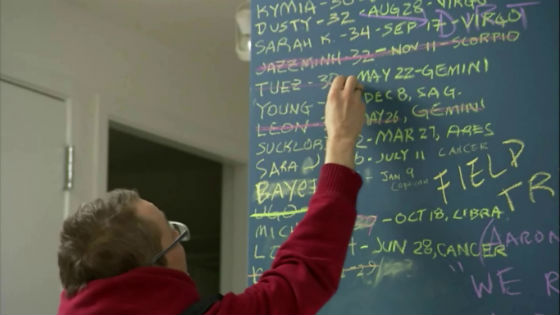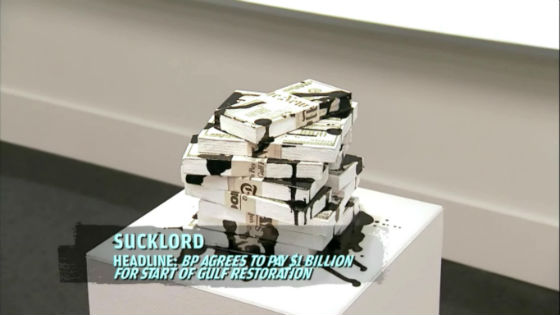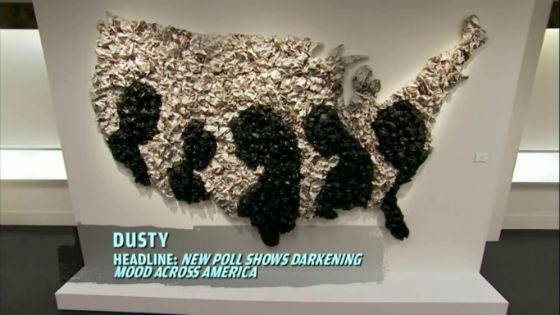The future of art blog humor now rests in the capable hands of Dusty Mitchell.
As the show begins in earnest, Simon de Pury arrives at the artists' hotel to wake them up and get them ready for art. This is something of a Bravo tradition – every one of their reality shows has an episode where the participants' space is invaded by cheery camp counselor-types – but it seems a bit cruel to Simon. Rather than imagine the auctioneer debasing himself so, instead substitute this: Simon de Pury simply enjoys waking people up. It makes the entire series an exultation, and washes away some of the oily film of manufactured reality. Some of it.
Once Simon has shepherded the artists out of the hotel room – a process which requires repeated shots of Young in his underwear – it becomes apparent that Bravo is done with its great contemporary art experiment. The artists are forced into a cheap, disposable-looking van, driven to the far edge of Queens, and unloaded in an empty industrial park. Struggling to remember their route, Dusty observes that the other artists are at an advantage, since they know the geography of New York and he does not; he has not yet grasped that all of this will soon be meaningless.
The artists enter the imposing, windowless industrial shed they have unloaded beneath. It is introduced as the printing press for the New York Times, a token reassurance that evaporates once it becomes apparent that the building has no human workers. This is, perhaps, the better to avoid witnesses.
Once the contestants have arrived and are properly arranged in a firing line, China announces the next challenge: chose a headline from which to make a work of art for a cash pot of $20,000 and an exhibition venue in the offices of the Times. This prompts the usual speculation from the contestants, as they struggle to identify advantages and disadvantages. Lola feels secure: her family has long subscribed to the paper, and this has given her the ability to make good art. Conversely, Kymia appears unsettled: she doesn't read the paper, and this prevents her from making good art. Given ten minutes to choose their headlines, the artist set themselves to the task of digging around in a giant pile of newspapers and occasionally throwing issues up in the air.
Step two fof the challenge involves a trip to Utretcht for art supplies. Lola as always, freaks out: “This challenge is making me feel really emotional and scared.” She also doesn't have a clear idea of what she's going to do, which is becoming something of a theme.
Sarah Kabot chooses a story about an author descending into madness, and decides to express this by obsessively cutting the story up. So it looks like madness. No one mentions that this is the ultimate folk art cliche, presumably because there's no time to knock down all the overdone concepts in this show. Bayete will paint a door gold to talk about the use of ornamentation as attraction in organized religion. The idea sounds suspiciously complex for the artist, in that it actually matches the story he selected, “Different Churches, More Sequins”. Well, sort of: the headline is for a piece about the Broadway musical Sister Act 2.
Back at the studio, an early snag. Young Sun, who has decided to explore censorship through a piece on Ai Weiwei, discovers bleach won't make the text on his newspapers disappear. The clock is a-ticking! Young Sun worries he'll be kicked off the show because he's fallen behind, but that's about as obvious a herring as Bravo throws out. At this point, no one seriously expects the judges to eliminate Young.
Other artists seem to be doing reasonably well; Lola's headline is about the Libyan rebels having nonfunctional weapons, so she makes a sword out of newspaper. Michelle picked an article about needing to prove injuries, and draws on the experience of taking photos for her insurance claims after her backstory car accident. Since Bravo regularly conflates the criteria for good TV with the criteria for good artwork, this piece seems likely to do well.
Dusty's usual literal-mindedness marks his work, which is drawn from a headline that reads, “New Poll Shows Darkening Mood Across America”. The article is about how the nation's feelings about the economy are affecting Obama's disapproval ratings, which makes Dusty ball up a bunch of newspapers to make sad map of the country with sad silhouettes of people in the middle.
Apparently readying herself for a massive Halloween party, Kymia decides to make a plaster coffin with feet sticking out. Her story is about a serial killer, so her work's gonna be creepy. Sarah Jimenez also decides to do death, which is in keeping with the amount of eyeliner she wears. Her work is about Japanese farmers affected by the recent nuclear disaster, so she makes a drawing of farmers with cows on a pile of bones.
There's nothing like a pile of bones to transition a scene into Simon's entry. Doom music cued. As usual, the crits are a total waste of time. Simon tells Lola her work is “much more advanced than I've ever seen” while looking at a stack of newspapers with a small hole dremeled into the top. On that visual alone, he's right. Other artists receive mixed reports; Sarah K gets it for middling and The Sucklord for lack of transformation; his wood-backed newspaper isn't exactly pushing forward his headline about BP's $1 billion settlement. Surprisingly, Bayette earns some positive speculation; according to Simon, the piece has “wall power” potential, assuming he doesn't do his usual and overwork it. No one in this office holds much hope for that.
After Simon's visit a litany of ridiculous scenes ensues. Sucklord asks the group if he can make up his own headline, but Michelle complains that he's changing the rules. One has to assume some discussion about Young Sun running with his own title got cut when this issue came up, because his whole piece is now based on a headline he made up. In another shot, Sarah J's crying in a previous episode is described as being particularly bad because it happened in front of Sarah Jessica Parker. That it occurred on national TV is, apparently, only a secondary concern. Ultimately, it's inconsequential: Sarah J informs us that she's a Cancer, which means she will find strength within herself to deal with the Sarah Jessica fallout.
If the Sucklord gives two shits about astrology, he's not yet let on. He ditches his project when Lola tells him to, which means he's relying on advice from a similarly questionable source. Still, the decision makes sense, mostly because the piece used far more Smurf Blue than could ever work. Bayete, for his part, manages to paint the wrong side of his door and Sarah K's piece gets slammed by Kymia, who complains that it doesn't make sense. This would be a fine conclusion had it been applied to the work of anyone else on the show, but Sarah K's problem is the same one she always has; her work is formulaic to the point of boredom.
One scene later, out come the judges. Adam McEwen is the guest judge this week, and since he works with text, it's his job to point out to Jerry Saltz that there are silhouettes in Dusty's piece. Saltz apparently did not notice this. It's unclear whether he is a victim of Bravo's inventive editing, or simply blind.
Lola is probably right when she identifies her piece as not very good — like everyone else's work it's pretty literal — but since no clear shot of the drawing is given to the cameras we're just guessing. Michelle cheats and works her headline physically into the piece by using it to prop up her painting Chris Ofili-style. In other obvious borrowing, Robert Gober is the precedent for Young's piece. He's blackened all of his newspapers and given them the new headline: “Where is Ai Weiwei?”.
Where Ugo received a brisk dismissal for aping Keith Haring, we never hear Gober's name once. Instead, we listen to platitudes: “It's today's news that shouldn't be forgotten because its bundled up like yesterday's news”, Saltz opines. Well, okay, but one could just as easily read those stacks as ready for delivery- and what of Young playing the censor? Ai Weiwei's head was on the front page of the newspaper until he removed it. Or: Where is Ai Weiwei? Right there.
No matter; he's a favorite, as is Lola and, um, Dusty. Apparently Dusty's work is good because it took a while for the judges to notice the figures. Young, though, ultimately takes the win; presumably, this is a reward for producing the most topical piece of the group. That might actually be a fitting criterion for a newspaper-based work; it might also be absolute nonsense.
Cut to the elimination round, and we're looking at the Sucklord's stack of money covered in oil and bound by the NY Times. Sucklord seems to think the media is somehow complicit in the BP oil spill, which sounds crazy. When Bill Powers attempts to say as much, though, his words are spliced together; somehow, he's made to call the piece crazy but also “utterly predictable”.
Sarah K and Bayete's pieces are both knocked for lacking obvious connections to their headlines. For Sarah K, this is an unfortunate consequence of obscuring the headline; for Bayete, this is because his piece lacks any connection whatsoever. Ultimately, Bayete gets the axe, four episodes late. To his credit, he exits well. “It was such a bad piece”, he reflects, saying he would have felt bad if anyone else had gotten the cut instead. We're told, as Bayete fans, to expect better of him in future. Fortunately for both him and us, we won't have to watch that play out on TV.






{ 1 comment }
is it me or is the height of bill powers hair morphing him into a trendy beavis and butthead
Comments on this entry are closed.